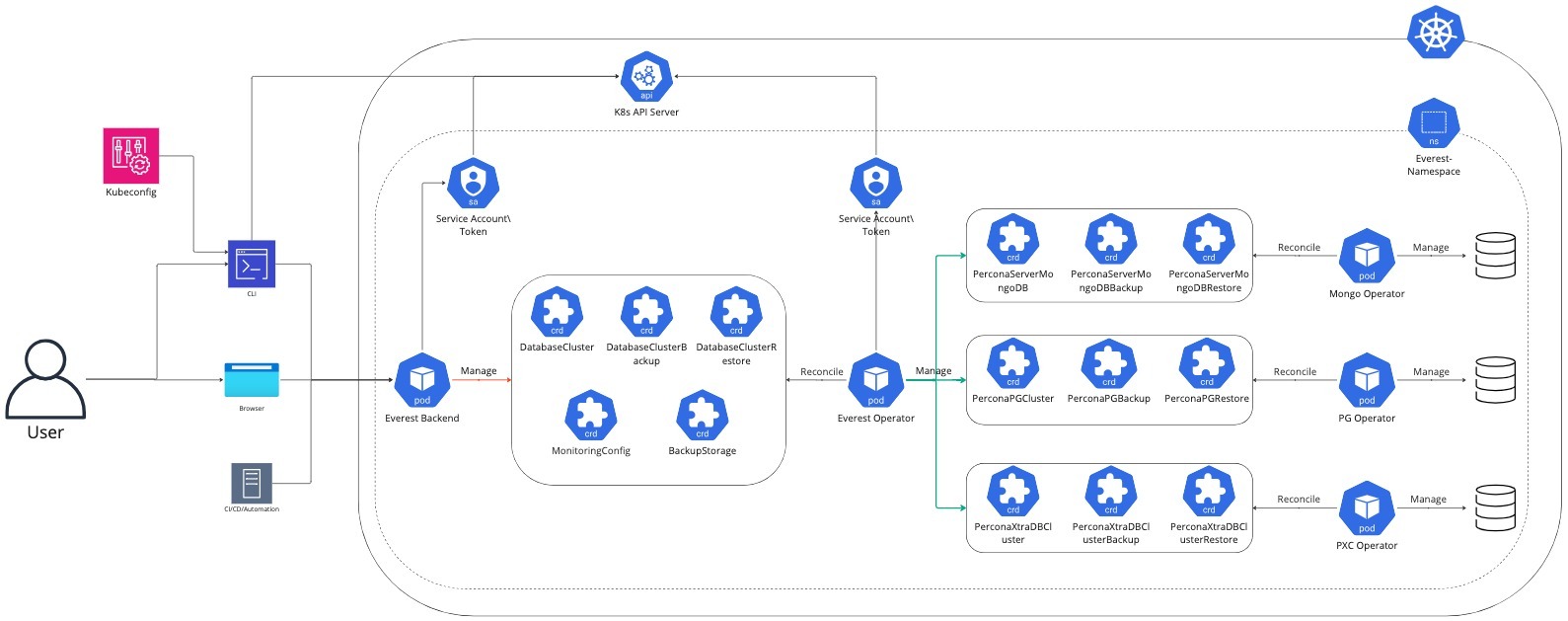
Be an early adopter and join us in driving its progress!
Your feedback is crucial to enhancing the software, and we highly value and rely on your input.
<img sizes="100vw" srcset="/images/everest/everest-07-1-intro_hu_c76109d9e79c5e9a.jpg 480w, /images/everest/everest-07-1-intro_hu_860068492f0b368a.jpg 768w, /images/everest/everest-07-1-intro_hu_463510507656c50.jpg 1400w"
src="/images/everest/everest-07-1-intro.jpg" alt="Percona Everest Intro" /></figure></p>
Percona Everest is a cloud-native database platform to deploy and manage enterprise-grade PostgreSQL, MongoDB and MySQL database clusters.
Your databases will come pre-configured with optimal parameters and settings tailored to the available resources, ensuring a seamless and efficient deployment experience.
Who is Percona Everest for?
SRE/DevOps professionals: Administrators responsible for deploying and configuring the initial setup and managing upgrades.
DEV/DBA teams: users operating on databases, performing tasks such as deployment, backup, restoration, and scaling.
If you require highly available database clusters with multiple nodes in Kubernetes, Percona Everest is designed to meet your needs.
What is Percona Everest?
Simplified Database Cluster Management with an intuitive browser interface
Effortlessly create, scale, back up, and restore databases without the hassle of dealing with multiple YAML files and intricate terminal commands.
Optimized viewing experience with Light and Dark themes
<img sizes="100vw" srcset="/images/everest/everest-07-2-start_hu_abedd79f3bbf1a3e.jpg 480w, /images/everest/everest-07-2-start_hu_47e805192a6494d.jpg 768w, /images/everest/everest-07-2-start_hu_43448007d403453a.jpg 1400w"
src="/images/everest/everest-07-2-start.jpg" alt="Percona Everest Start" /></figure></p>
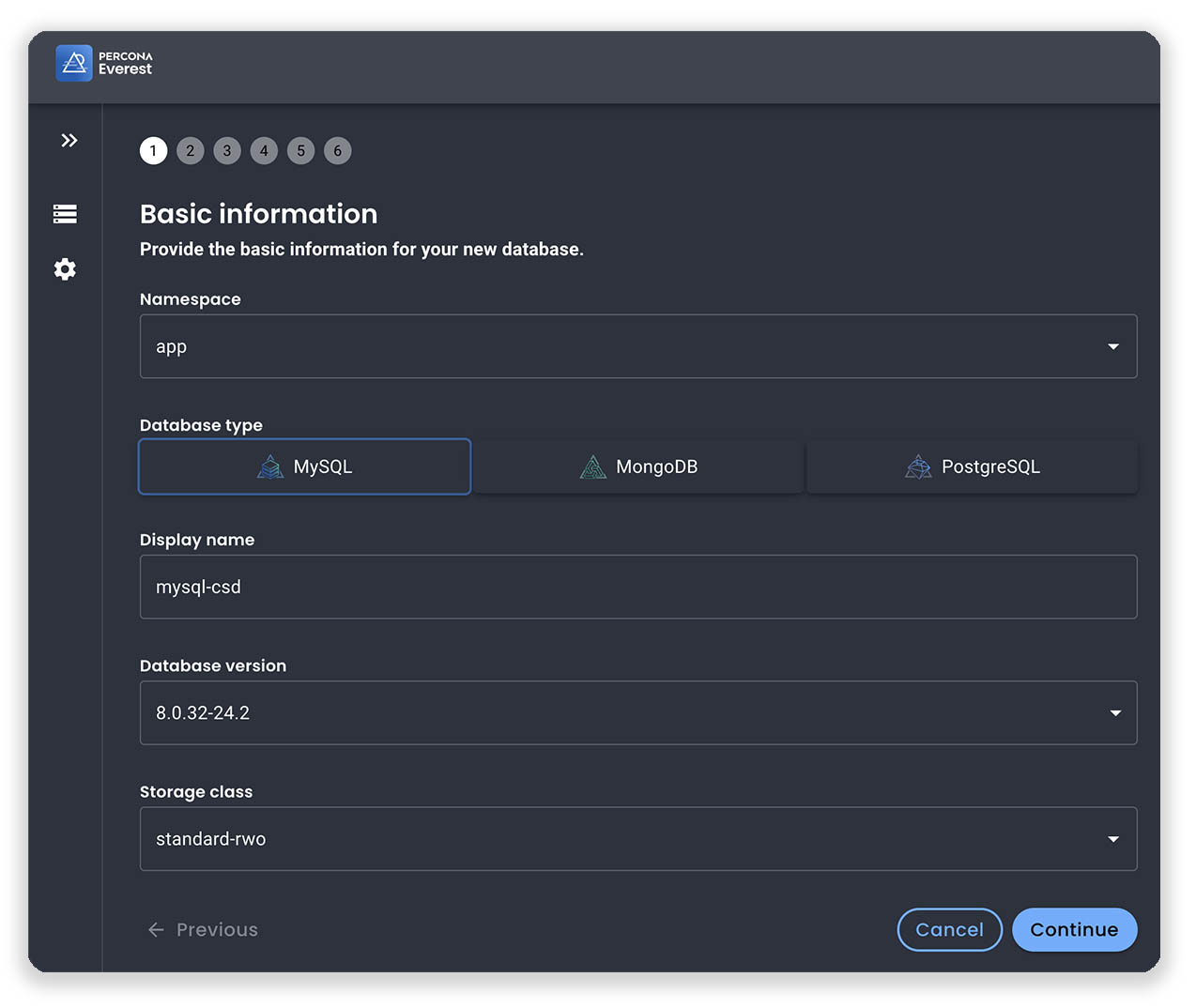
Support for diverse database technologies
Create clusters of various open-source databases:
- MySQL
- PostgreSQL
- MongoDB
Everest leverages Percona Operators to deploy Cloud-Native Percona Distributions.
You don’t have to be a seasoned Kubernetes engineer; Percona Everest streamlines the process of running databases in Kubernetes.
Enhanced Database Storage Class support
Effortlessly tailor your storage requirements with Percona Everest’s advanced database storage class support.
Efficiently allocate resources to strike the right balance between optimal performance and cost-effectiveness.
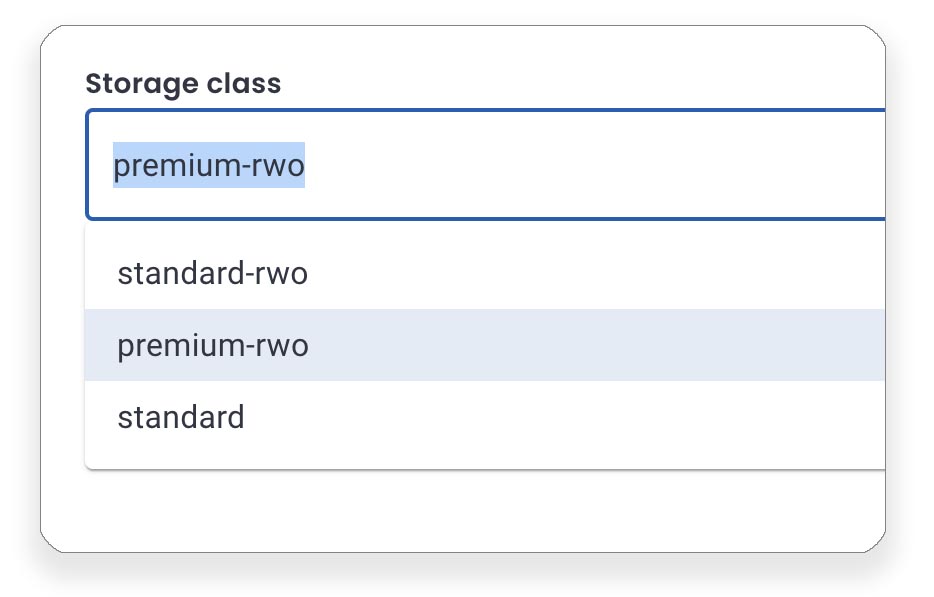
<img sizes="100vw" srcset="/images/everest/everest-07-8-resources_hu_dfd80d0ab02aab3f.jpg 480w, /images/everest/everest-07-8-resources_hu_2d1b7790566bb994.jpg 768w, /images/everest/everest-07-8-resources_hu_1ff1fa8945d43df2.jpg 1400w"
src="/images/everest/everest-07-8-resources.jpg" alt="Percona Everest Resources" /></figure></p>
Horizontal and vertical scaling Flexibility
Customize your infrastructure to meet your application’s evolving demands, leveraging the versatility of horizontal scaling for multi-node deployments and vertical scaling for single-node setups:
- Create a cluster with essential resources
- Adjust the number of nodes and allocated resources as needed
Sophisticated configuration capabilities
Exercise precise control over your database environment with advanced configuration features.
<img sizes="100vw" srcset="/images/everest/everest-07-9-advanced_hu_24ace4db47f935d4.jpg 480w, /images/everest/everest-07-9-advanced_hu_41b13bc1641a3be9.jpg 768w, /images/everest/everest-07-9-advanced_hu_fd9ba2b542050a69.jpg 1400w"
src="/images/everest/everest-07-9-advanced.jpg" alt="Percona Everest Advanced Configuration" /></figure></p>
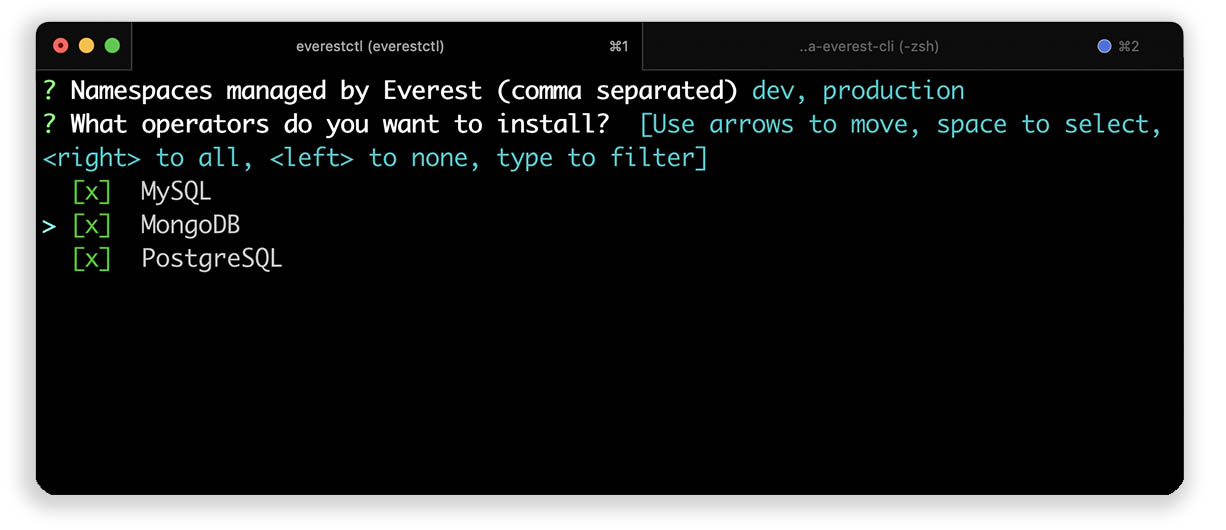
Streamlined installation with a single command
The Everestctl CLI tool ensures a simplified installation by deploying all necessary components in your Kubernetes cluster. Simply select the desired namespace and databases, and you’re all set up.
Percona Everest does not supply a Kubernetes cluster; you’ll need to use your own for the deployment. Prerequisites.
Cloud-native application
Everest installs inside the cluster, and harnesses Cloud-Native resources only.
Database provisioning is facilitated through the installation of OLM and Percona Kubernetes Operators.
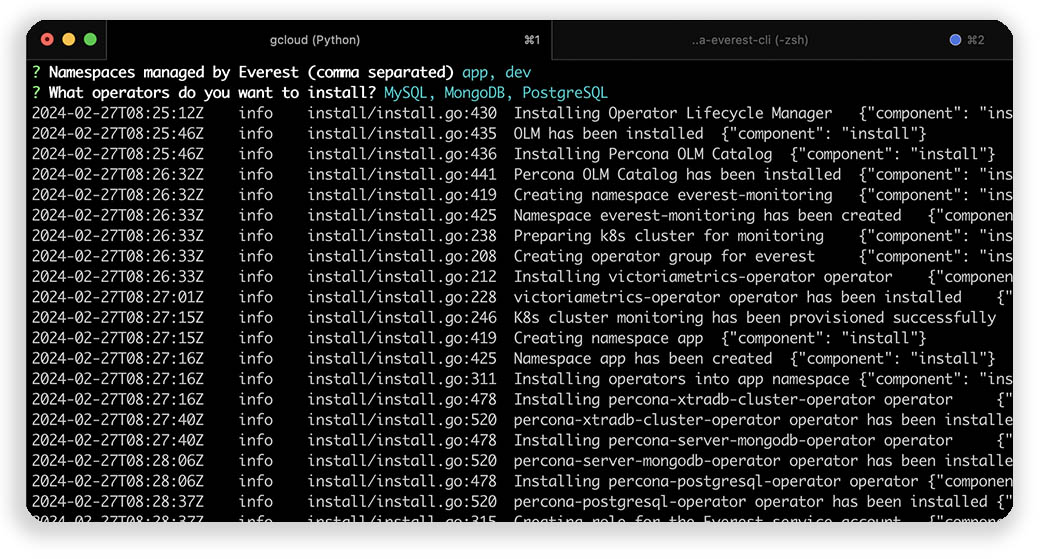
Enhanced Disaster Recovery capabilities
Percona Everest prioritizes data protection through a robust disaster recovery suite.
Configure backup schedules, generate on-demand backups, execute point-in-time recovery, effortlessly restore existing databases, or create new ones from backups seamlessly.
Secure backups to your preferred independent S3-compatible buckets
<img sizes="100vw" srcset="/images/everest/everest-07-10-backup-s3_hu_66fc3ae7cc449dc4.jpg 480w, /images/everest/everest-07-10-backup-s3_hu_6e89974abbad5108.jpg 768w, /images/everest/everest-07-10-backup-s3_hu_7604ef2ae8cca977.jpg 1400w"
src="/images/everest/everest-07-10-backup-s3.jpg" alt="Percona Everest S3 Bucket" /></figure></p>
<img sizes="100vw" srcset="/images/everest/everest-07-11-backup_hu_c9f63577c93dd4dc.jpg 480w, /images/everest/everest-07-11-backup_hu_320116d894af7709.jpg 768w, /images/everest/everest-07-11-backup_hu_c3dade19c8b585b.jpg 1400w"
src="/images/everest/everest-07-11-backup.jpg" alt="Percona Everest Backups" /></figure></p>
Scheduled Backups made simple
Define the frequency of database backup jobs, or opt for one-click manual backups for instant data protection.
Advanced Point-in-time Recovery (PITR)
PITR gives you continuous data protection with uninterrupted database backups.
PITR enables you to restore your database to a precise point in time, keeping it safe against accidental writes or deletions.
<img sizes="100vw" srcset="/images/everest/everest-07-12-pitr_hu_2fdad155a6fd92ed.jpg 480w, /images/everest/everest-07-12-pitr_hu_2a59d8683d517a95.jpg 768w, /images/everest/everest-07-12-pitr_hu_c14c4d933c4a4b49.jpg 1400w"
src="/images/everest/everest-07-12-pitr.jpg" alt="Percona Everest PITR Point in time recovery" /></figure></p>
<img sizes="100vw" srcset="/images/everest/everest-07-13-management_hu_40c72f95c0c89378.jpg 480w, /images/everest/everest-07-13-management_hu_fcb752f759610fb.jpg 768w, /images/everest/everest-07-13-management_hu_282433485744aab0.jpg 1400w"
src="/images/everest/everest-07-13-management.jpg" alt="Percona Everest Management" /></figure></p>
Easy database management
Create, edit, pause, and restore backups from a unified command center.
Comprehensive database monitoring with PMM
Keep a watchful eye on your databases and Kubernetes clusters using the integrated Percona Monitoring and Management (PMM) tool.
Connect PMM to monitor and troubleshoot your databases.
<img sizes="100vw" srcset="/images/everest/everest-07-14-pmm-endpoints_hu_c523f79e59fefc50.jpg 480w, /images/everest/everest-07-14-pmm-endpoints_hu_83c9fdc5d3584e56.jpg 768w, /images/everest/everest-07-14-pmm-endpoints_hu_43727f65bbbbac0e.jpg 1400w"
src="/images/everest/everest-07-14-pmm-endpoints.jpg" alt="Percona Everest PMM Monitoring Endpoints" /></figure></p>
Gain insights into performance metrics, query analysis, and more.
<img sizes="100vw" srcset="/images/everest/everest-07-15-pmm_hu_8644f05e7819ddf4.jpg 480w, /images/everest/everest-07-15-pmm_hu_af1158514965fa9f.jpg 768w, /images/everest/everest-07-15-pmm_hu_f0a469ce856123bf.jpg 1400w"
src="/images/everest/everest-07-15-pmm.jpg" alt="Percona Everest PMM" /></figure></p>
How can you help?
We look for early adopters and contributors to drive it forward - we need your feedback to improve the software.
Start with the Percona Everest documentation
Share Feedback and Ask Your Questions on the Forum
Percona Forum - Percona Everest category
Content Creation
We would appreciate any initiatives you take to create content about Percona Everest. We invite you to write a blog post, social media post or make a YouTube video.
If you need help or want to share something, email community-team@percona.com.
Watch Percona Everest tutorials
- How To Use Percona Everest UI to Manage Databases
- How to Backup/Restore Databases With Percona Everest
- How to Use PMM (Percona Monitoring & Management) to Monitor your Percona Everest Databases
- How to Scale Databases in Percona Everest
- Deploy a Kubernetes cluster on Amazon EKS
- Install Percona Everest and provision a MongoDB cluster
- Configure an S3 bucket and enable backups
- Install PMM and enable database monitoring
- Connect to MongoDB cluster created using Percona Everest
- Restore a MongoDB database from a backup
- Clear the test environment and remove the EKS cluster
Articles about Percona Everest
We invite you to read articles from the community
- Getting to know Percona Everest [Beta] — a tool for managing database clusters - by Andrew Fishday
- A Love Letter to Our Favorite Open Source Projects by Tyler Au
- Setting Up Your Environment for Kubernetes Operators Using Docker, kubectl, and k3dby Edith Puclla
- Percona Everest: Transforma la gestión de bases de datos cloud nativeby Julian Garcia
- A New Way to Provision Databases on Kubernetesby Daniil Bazhenov
- Lyrid Bare Metal Kubernetes Performance Benchmarkingby Handoyo Sutanto (Lyrid)
- Introduction to the New Percona Everest Betaby Vinicius Grippa
- Building an Open Source Private DBaaSby Piotr Szczepaniak
We look forward to your reviews and articles about Percona Everest.
Contribute Code
We encourage you to install, try, build, share and contribute code to Percona Everest and its components.
Guide how to make a contribution
GitHub
You can find Percona Everest code in these GitHub repositories:
In repositories, you can find the detailed information on building and launching components. Also, you can report issues directly in repositories.
We encourage you to contribute code and report issues to improve Percona Everest!
Percona Everest Architecture
Percona Everest App is an application with a web interface. It consists of two major components:
Percona Everest UI is a frontend application developed using the Vite framework, React library and TypeScript language.
Percona Everest Backend is the backend API that processes requests from the frontend app and sends them to the Kubernetes API. It is developed in Golang using the Echo framework.
Percona Everest CLI (everestctl) is a console tool used to provision and install Percona Everest operators and components to your Kubernetes Cluster where Percona Everest will create and manage database clusters. Everestctl is developed in Golang language, and it is as a built executable file.
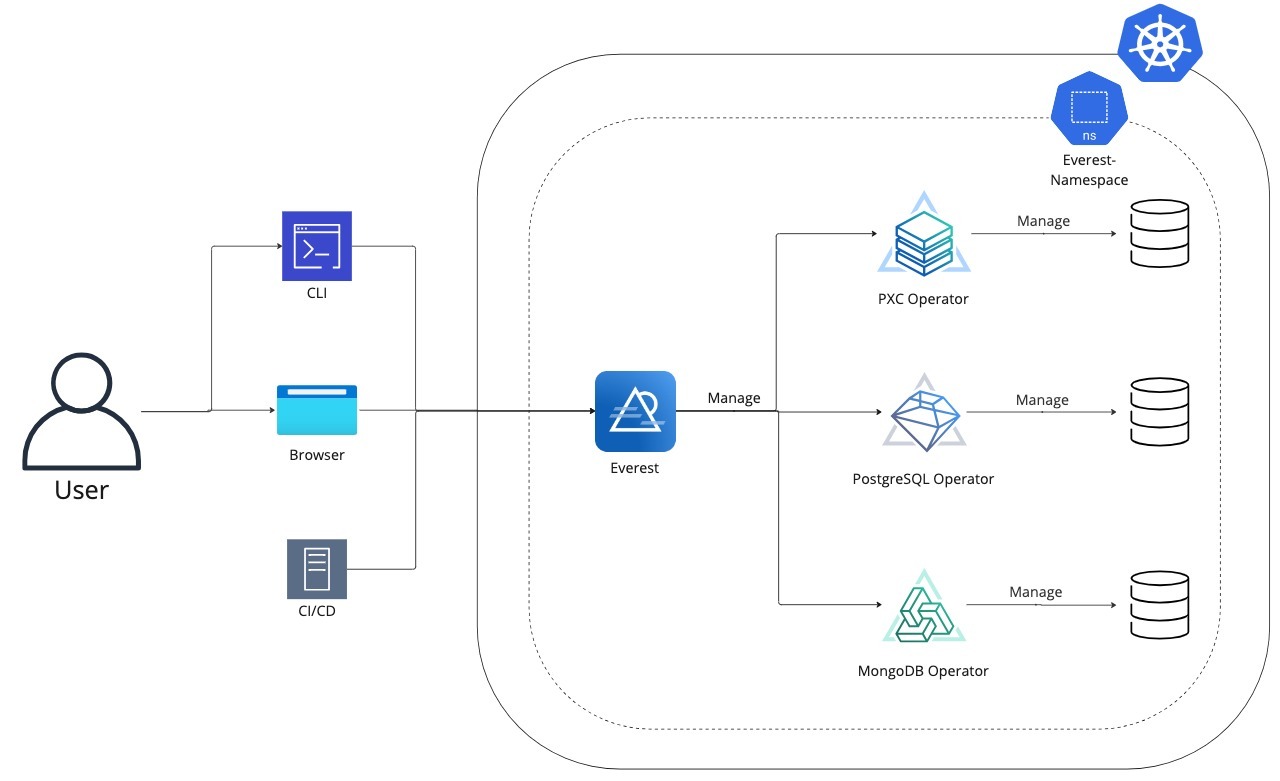
Also, Percona Everest uses:
Percona Everest Operator that rely on underlying operators for deploying DB clusters of a given engine type.
Percona Everest Catalog - an internal tool for everestcli.
